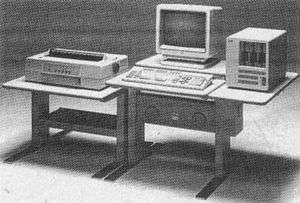IBM 5550
|
IBM 5550. From left, IBM 5553 Printer, IBM 5555 Display and IBM 5551 CPU | |
| Also known as | Multistation 5550 |
|---|---|
| Manufacturer | IBM |
| Type | personal computer |
| Release date | Japan March 1983[1] |
| Introductory price | US$4,200-10000 with screen, printer, and keyboard. |
| Operating system | Japanese DOS or OS/2 |
| CPU | Intel 8086 @ 8 MHz |
| Memory | 256 kB RAM (expandable to 512 kB) |
| Display | 15-inch CRT display (24 lines x 80 characters) |
| Graphics | 1024x768 graphics monochrome or 360x512 in four colors |
| Successor | IBM Personal System/55 |
IBM 5550 is a personal computer series that IBM marketed in Japan, Korea, Taiwan and China in the 1980s and 1990s, for business use customers. In Japan, it was introduced in 1983 and promoted as "Multistation 5550" because it had three roles in one machine: a PC, a word processing machine which was traditionally marketed as a machine different from a PC in Japan, and an IBM-host attached terminal.
General
The IBM PC that had been marketed by IBM since 1981, using Intel 8088, was not powerful enough to process the far eastern languages of Japanese, Korean and Chinese. Nor was the resolution of IBM PC's VGA display high enough to show the complex characters of these languages.
The IBM 5550 was first introduced in Japan in March 1983,[1] using Intel 8086 microprocessor and was called "Multistation 5550" because it had three roles in one machine: a PC, a word processing machine which was traditionally marketed in Japan as a machine different from a PC, and an online terminal.
After the Japanese 5550 models, Korean, Traditional Chinese and Simplified Chinese models were also introduced. IBM 5550 initially used its own architecture, but, later since 1987, was changed to use IBM Personal System/2's Micro Channel Architecture, being renamed as Personal System/55.
In Japan, Kiyoshi Atsumi, a film actor, was used to promote the 5550. IBM later introduced IBM JX for home users in Japan, Australia and New Zealand, and DOS/V for both business and home users in Japan.
Its features
IBM 5550's features are:
- Intel 8086 microprocessor
- 15-inch CRT display of 24 lines of 80 characters each, each character 24×24 or 16x16 dots
- Up to three 5¼ inch double-density (720 KB) floppy disk drives
- Japanese DOS or OS/2
- Application programs, such as Japanese Bunsho Program for word processing, 3270 emulation or 5250 emulation for IBM host communication, etc.
Its models
- 5551-A/B/C/D/E/G/H/J/K/M/P (Basic models, placed beside the display. Later became a smaller size like 5540)
- 5541-B/E/J/K/M/P (Smaller size models, on which the display can be placed. Later made even smaller)
- 5561-G/H/J/K/M/P (Larger size models)
- 5530-G/H (Stand-alone models, without the communications adapter. Used 3½ inch floppy disk)
- 5535-M (Laptop, using 3½ inch floppy disk)
Competition
In Japan, Multistation 5550 competed against:
- Fujitsu FMR Series
- NEC PC-9801 Series and NEC N5200/5300 Series
Reception
BYTE in 1983 speculated that "we may soon see a similar machine here in America". Describing the 5550 as "a true workstation", the magazine envisioned the computer as filling the "considerable gulf above the PC", and a rival to the IBM System/36 minicomputer. It praised the 5550's "unprecedented" combination of kanji support with high-end word-processing capability, and reported that in Japan an ecosystem of vendors providing products for the computer was forming. The magazine concluded that "if the American PC is any precedent, the market should soon be filled with 5550 software".[2]
See also
References
- 1 2 Chronology of IBM Personal Computers (1983-1986), Ken Polsson Archived March 15, 2012, at the Wayback Machine., 1983, March 15, IBM Japan announces the IBM 5550 Multistation in Japan. It features an 8 MHz Intel 8086 microprocessor, 256 kB RAM (expandable to 512 kB), up to three 640 kB capacity floppy drives, display with 1024x768 graphics monochrome or 360x512 in four colors, for US$4200-10000 with screen, printer, and keyboard. [902.144] [1314.D4
- ↑ Willis, Richard (November 1983). "Big Blue Goes Japanese". BYTE. p. 164. Retrieved 19 March 2016.
External links
- (Japanese) Introducing Multistation 5550 (describes the models in detail)
